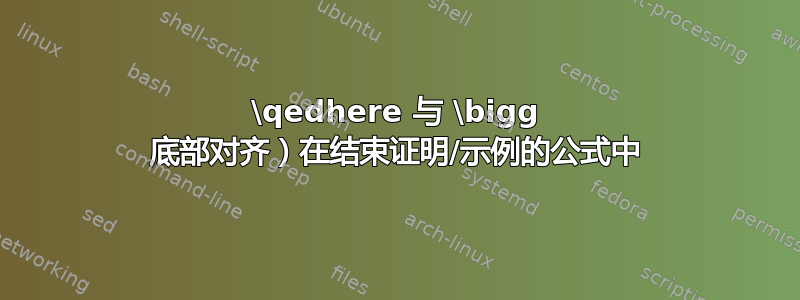
这是对此的后续问题回答。
这里对用户提供的 MWE 进行了微小的修改(我将/替换\bigg为):\bigl\bigr
\documentclass{article}
\usepackage{amsmath,amsthm}
\theoremstyle{definition}
\newtheorem{examplex}{Example}
\newenvironment{example}
{\pushQED{\qed}\renewcommand{\qedsymbol}{$\triangle$}\examplex}
{\popQED\endexamplex}
\begin{document}
\begin{example}
This has only text.
\end{example}
\begin{example}
This has also a display at the end:
\begin{align*}
f(x) &= \bigg( g(x) \bigg) \\
h(x) &= \bigg( r(x) \bigg).\qedhere
\end{align*}
\end{example}
\end{document}
可以看出,示例末尾的符号与末尾的点对齐align(即与括号的中心对齐)。但是,我希望它与括号的底部对齐。
请注意,在标准环境中也会出现同样的问题proof。
我能实现我的目标吗?
(当然,\bigg)只是一个参考点。该解决方案应该适用于公式中不采用标准间距的任何类型的符号。)
答案1
我不确定我是否推荐这种风格,但这里有两种\qedhere用于align和gather上下文的变体。它们的工作原理是向结构中添加一条额外的线,然后垂直后退适当的量。
\documentclass{article}
\usepackage{amsmath,amsthm}
\theoremstyle{definition}
\newtheorem{examplex}{Example}
\newenvironment{example}
{\pushQED{\qed}\renewcommand{\qedsymbol}{$\triangle$}\examplex}
{\popQED\endexamplex}
\newcommand{\alignqedhere}{\\[\dimexpr-\baselineskip+\dp\strutbox]
&\qedhere}
\newcommand{\gatherqedhere}{\\[\dimexpr-\baselineskip+\dp\strutbox]
\qedhere}
\begin{document}
\begin{example}
This has only text.
\end{example}
\begin{example}
This has also a display at the end:
\begin{align*}
f(x) &= \bigg( \frac 1{g(x)} \bigg), \\
h(x) &= \bigg( \frac{p(x)}{q(x)} \bigg). \alignqedhere
\end{align*}
\end{example}
\begin{example}
This ends with an ordinary equation but set as \verb+gather+
\begin{gather*}
x = \frac12. \gatherqedhere
\end{gather*}
\end{example}
\begin{example}
Here is another example
\begin{gather*}
f(x) =
\begin{cases}
1&\text{for \( x>0 \),}\\
0&\text{otherwise.}
\end{cases}
\gatherqedhere
\end{gather*}
\end{example}
\begin{example}
\begin{gather*}
\begin{split}
y &= z\\
&= \frac 1\pi.
\end{split}
\gatherqedhere
\end{gather*}
\end{example}
\end{document}



